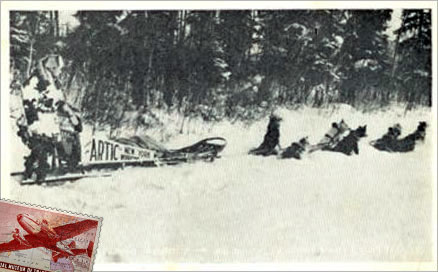A Fort Garry couple are hot on the trail of two Manitoba dog mushers who travelled from the Arctic to New York City in 1938-39.
Anne and Graham Gieg have been gathering clues since last May about the odyssey of Graham's great uncle, Leland Abbott, and his friend Hector Despins, and plan to write a book about the off-beat adventure. "It's the family legend," says Gieg, who recalls a visit to his great-uncle's house when he was 10 years old. "The house was full of incredible keepsakes from all the places he'd travelled."Unfortunately, much of that material has been lost.
"It's been a bit of a detective story," he says.
The Giegs have been gathering material from newspapers, family members and the Hudson's Bay Company archives, and by soliciting memories from people who met the mushers during their trip.
The story is an intriguing tale of contrasting worlds, says Gieg, containing within it the wilderness of the North and the metropolis of New York City, the solitude of the trapper's life and life in the media spotlight. It's also the story of one last civilian adventure before the attention of the world -- and the energies of the two adventurers -- became focused on the Second World War.
Abbott and Despins were trapping muskrats and guiding mineral prospectors around a settlement called Tavane, in what is now Nunavut, when they read a six-month-old magazine article about people travelling to the New York World's Fair by unusual means. As muskrat pelts weren't fetching much of a price at the time, they decided in the fall of 1938 to mush to the fair at Flushing Meadows, N.Y.
The trip was full of unexpected twists and turns. They ran out of snow around Dauphin, and a farmer helped them to create a wheeled sled. Unfortunately, the powerful sled dogs were no match for the home-made contraption and it fell apart soon after.
From Winnipeg on, the mushers travelled on a more durable wheeled sled made from a car chassis, following a convoluted route that took them to Chicago via Iowa. Chicago turned out to be a rough town, even with Al Capone in jail, and the duo nearly rolled into a bank robbery and shootout.
That's not the only aspect of the story that seems made for Hollywood. Abbott actually met his wife-to-be during a stop in Pennsylvania.
Arriving in New York in April, 1939, in time for the opening of the World's Fair, Despins and Abbott and their dogs became celebrities.
"The lead dog is supposed to have been the first dog on television," says Gieg, explaining that RCA first unveiled the brand-new technology at the New York fair. "This was 20 years before Lassie."
They visited hospitals, participated in a travelling show, and attended openings of a James Cagney movie called Torrid Zone and, more appropriately perhaps, a Sgt. Preston movie. They also met boxing champion Joe Louis, according to legend, taking the dog team to the boxer's training camp in New Jersey.
Eventually they returned to Canada to enlist in the Armed Forces. Despins was declared medically unfit because of an earlier injury, says Gieg, but he ended up driving bulldozers during the construction of the Alaska Highway in 1942-43. Abbott joined the Royal Canadian Air Force in 1941 and became a bomber pilot.
After the war, Despins became a mining engineer and was involved in developing Thompson's nickel mining industry. Abbott "fell in love with the ocean," says Gieg, and eventually opened a fish business on the coast called Eskimo Abbott's Frozen Fish.
Fascinating as the journey was, the Giegs have discovered that it was by no means unique. A string of Canadian adventurers undertook long dog sled trips in the 1930s, including William Campbell, who mushed from The Pas to Chicago for the 1933 World's Fair, and King Taylor, who mushed from The Pas to Halifax and back.
The Giegs expect to spend another year digging up details of the journey, and hope to wrap up their investigation by following the dog sledders' path -- in a more conventional vehicle.
Anyone with information about the adventure can call the Giegs at 832-2606.
Winnipeg Free Press print edition 27.03.2002

